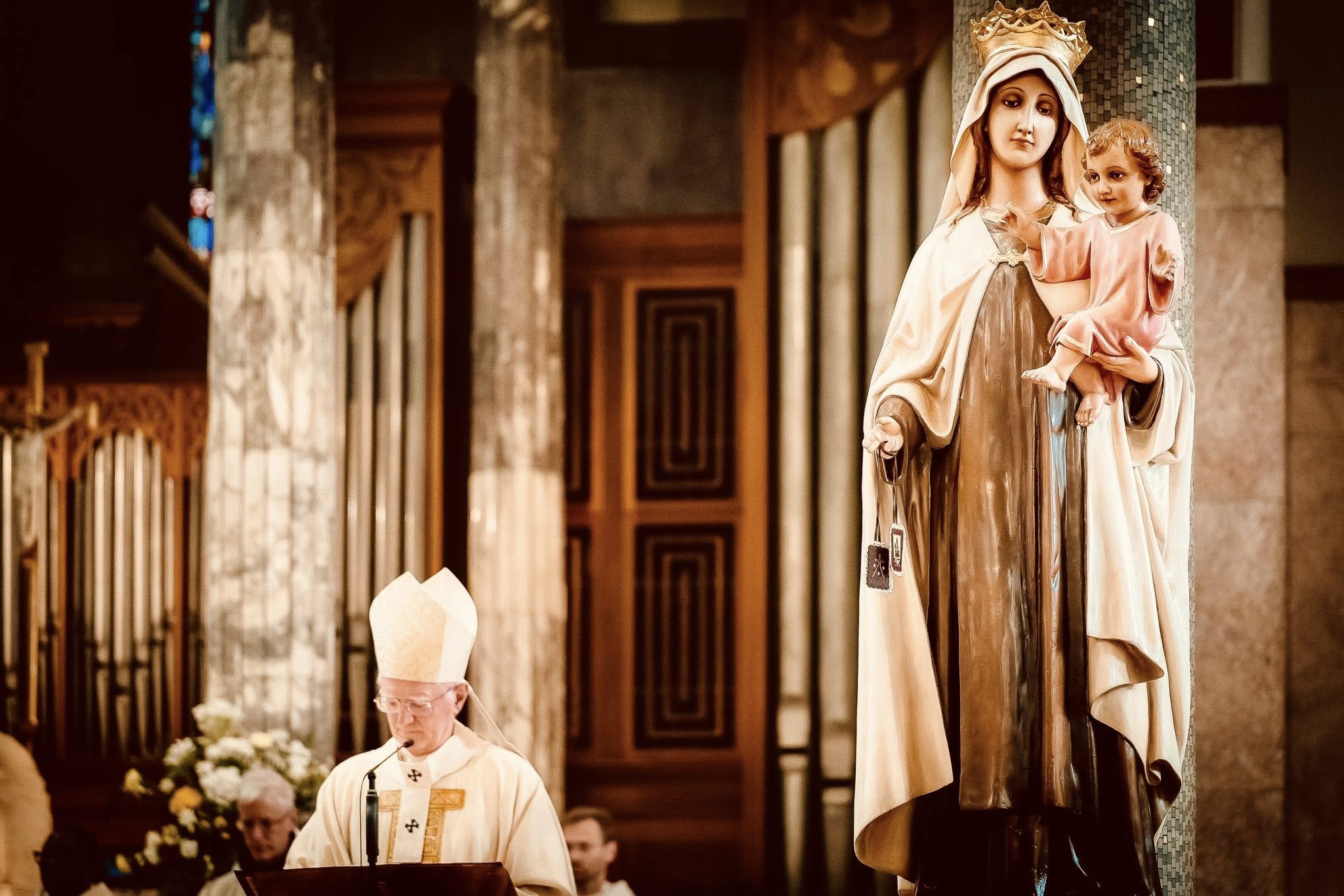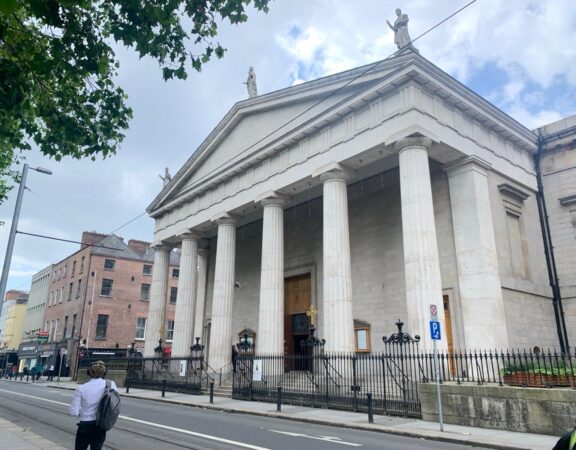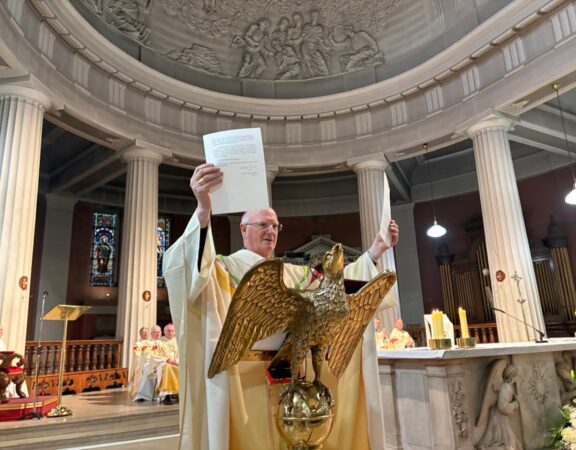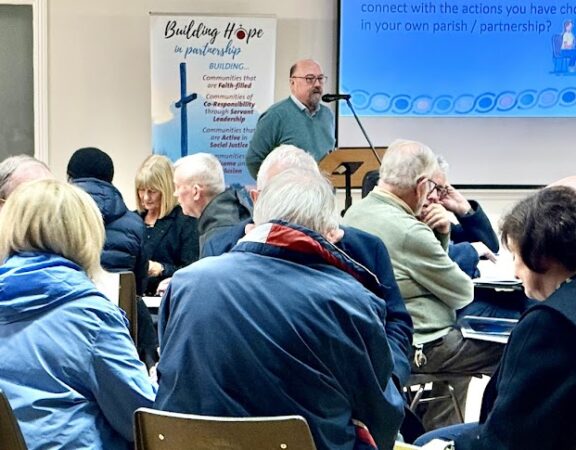Feast of Our Lady of Mount Carmel
Whitefriar Street Church
Wednesday, July 16, 2025
Homily of Archbishop Dermot Farrell
We thank God for gathering us this afternoon to honour of the Blessed Virgin Mary in her title, Our Lady of Mount Carmel. I welcome all of you, parishioners of this parish and those with a devotion to Our Lady, and most especially the members of the Carmelite Family.
Mount Carmel plays an essential role in every Carmelite’s life, spirituality, and mission. In the life of every Carmelite, there is always a longing, through the help of Our Lady of Mount Carmel, to ascend to the holy mountain, which, according to our Opening Prayer, is no other than Christ. Fully accepting the Word, Mary “reached the holy mountain” (Opening Prayer), and lives forever, in soul and body, with the Lord.
The First Reading from the Book of Kings (18:42b-45a) is about seeing the signs of God’s presence and God’s action—in our lives, in the Church, in the world. Elijah’s servant had to look repeatedly before he could see the sign of God’s presence and action. He had “go back seven times” before he saw a very tiny sign, rising from the sea (1 Kgs 18:43). The awakening to the sensibility to God by another prophet (Exod 3:5) is captured by Elizabeth Barrett Browning in her poem “Aurora Leigh”:
“Earth’s crammed with heaven,
And every common bush afire with God;
But only he who sees, takes off his shoes.”
(Elizabeth Barrett Browning, “Aurora Leigh” Book VII, lines 821-23)
Such an awakening is gentle, but confident because it is born of trust in God, and for many of a closeness to the Blessed Virgin Mary. With our vision cleared we see not only is God in all things, but all things are in God. For Elijah and his servant there are two parts: the persistence and the seeing. This is the heart of what we can do. God will come to us in God’s own time. An important part of prayer is waiting: waiting for God to speak, waiting for God to show his hand, waiting for God to reveal his presence. Simone Weil (1909-1943) was a French Jewish mystic who, on her journey to the truth, incisively said, “we do not attain the most precious gifts by going in search of them but by waiting for them…This way of looking is, in the first place, attentive.” (Simone Weil, Waiting on God, p. 169). Be attentive, listen with the ear of your heart. Our entire life is a profession of faith in hope. To wait in hope is a key expression of faith. Living faith is much more about waiting in hope for God to reveal himself than it is about signing up to a set of beliefs we feel we are asked to accept.
The prophet Elijah is the one who knows his Lord, and knows the Lord’s ways, and the Lord’s faithfulness to his word, to his covenant, and trusts in what God will do. Behind the wonder-working of the prophet we can discern the directing and succouring hand of God. Our call is to be a place where the mystery of God can unfold. Where God brought Elijah is where God brings all who turn to him.
The prophet has come to know God through the spiritual practice of attunement. Elijah persevered humbly through fear and human weakness to do whatever God asked of him, never giving in to doubt. He was able to recognise God’s presence in the “sheer silence”. (1 Kgs 19:12). Everything we listen to should only be a preparation for listening to what remains silent. The fruits of love, joy, peace, patience, kindness, gentleness and self-control which have been produced in our hearts by the Spirit of Jesus (Gal 5:22) are very important pointers to where we should look to find the signs of God in our world. And how will we recognise the signs of God in the world? Surely by “calling to him while he is still near” (see Isaiah 55:6), by giving him time, by allowing his light to shine, by discovering—and tasting—his vulnerability and weakness in our own (see 1Cor 1:25, cf. 2Cor 12:10), by letting the Spirit come upon us also, bringing God’s good news to us who are poor (see Luke 4:18, cf. Isa 61:1).

The prophet is not alone; he and his servant work together— this is community in the service of the Lord; synodality by another name; the true character of all interaction with God; the true character of the Church. In our highly connected society, no parish or religious community can think of living in isolation (see “Pathways for the Implementation Phase of the Synod 2025-2028”, §2.3).
Synodality is a word which aptly expresses how the Spirit shapes the Church. When the Holy Spirit is present, “there is movement, a journey to be made. We are a people on the move.” Synodality “demands that we each recognize our own poverty and our riches, that we feel part of a greater whole, apart from which everything withers, even the most original and unique of charisms.” (see Pope Leo XIV, Address to the Moderators of Lay Associations and Ecclesial Movements, June 6, 2025).
Mary, the Mother of God, is the perfect disciple, the prime example of discipleship, and an icon of synodal life, reminding us of the universal call to listen attentively to God with an openness to the Holy Spirit. As Carmelites you have spread devotion to the Blessed Virgin Mary under the title Our Lady of Mount Carmel, pointing to her as a model of prayer, contemplation and dedication to God. Through Mary’s attentive listening and openness to God, she fulfilled more perfectly than any other sheerly human person her mission in making God visible to the world. Mary, in fact, before and in an unsurpassable way, believed and felt that Jesus, the incarnate Word, is the culmination, the summit of our encounter with God. Some of the defining qualities of Mary, Mother of the Church, are tenderness, self-sacrifice, the capacity to listen and to hear the word of God and do it. Those same qualities which are reflected in the maternal dimension of the Church enable her not only to assist others, but often to anticipate their needs and expectations before they are even expressed. We hope that those qualities will be increasingly present in the people of God who are gathered here this afternoon to honour Our Lady of Mount Carmel.
This afternoon as we follow in the footsteps of our Blessed Mother and come to celebrate this beautiful feast of Our Lady of Mount Carmel, we spill out our sadness, mourn our disappointments, and stir our old hopes. At some moment our eyes will open and we will recognise the crucified Lord in the Risen Christ who is walking with us now. Our Lady of Mount Carmel shows us the way. In the Carmelite liturgy for the feast of our Lady of Mount Carmel we contemplate Our Lady as being “near the Cross of Christ”. She followed her Son who in the divine plan of salvation, cannot be separated from his Mother, from Mary, who “advanced in the pilgrimage of faith and faithfully persevered in her union with her Son until she stood at the cross” (Lumen Gentium No. 58). Beneath the cross, we see our Lady as symbol of the Church. She took upon herself her own portion of suffering, of darkness, of confusion, and she walked the way of the passion, keeping the lamp of faith lit in her heart. Standing under the cross Mary’s motherhood opened to embrace every one of us and our lives. With God’s grace, we too can make this journey. And, along the daily way of the cross, we meet the faces of so many sisters and brothers in difficulty: let us not pass them by, let us allow our hearts to be moved with compassion, and let us reach out to them.
Together, we pray and listen to the words of Jesus from the Cross, “This is your Mother”, and together we say, “Draw us after you, Virgin Mary, so we should follow in your footsteps”. May Mary help every Christian to meet God in the silence of prayer.
May Our Lady of Mount Carmel guide our steps through the steep and arduous paths of life. Our Lady of Mount Carmel, pray for us. Amen.
+Dermot Farrell
Archbishop of Dublin









